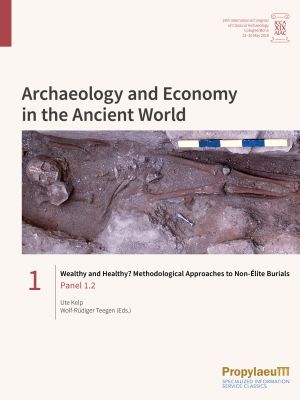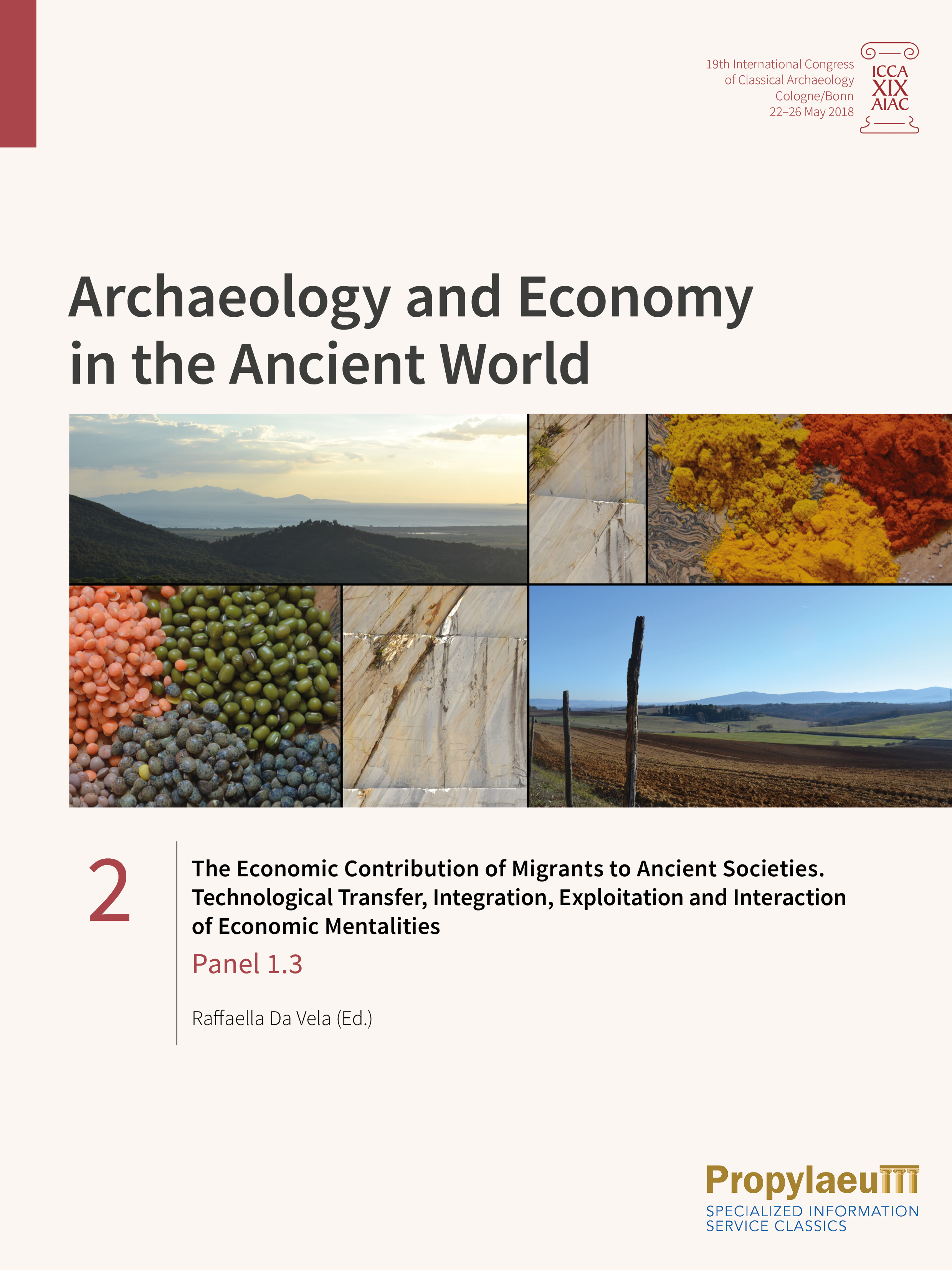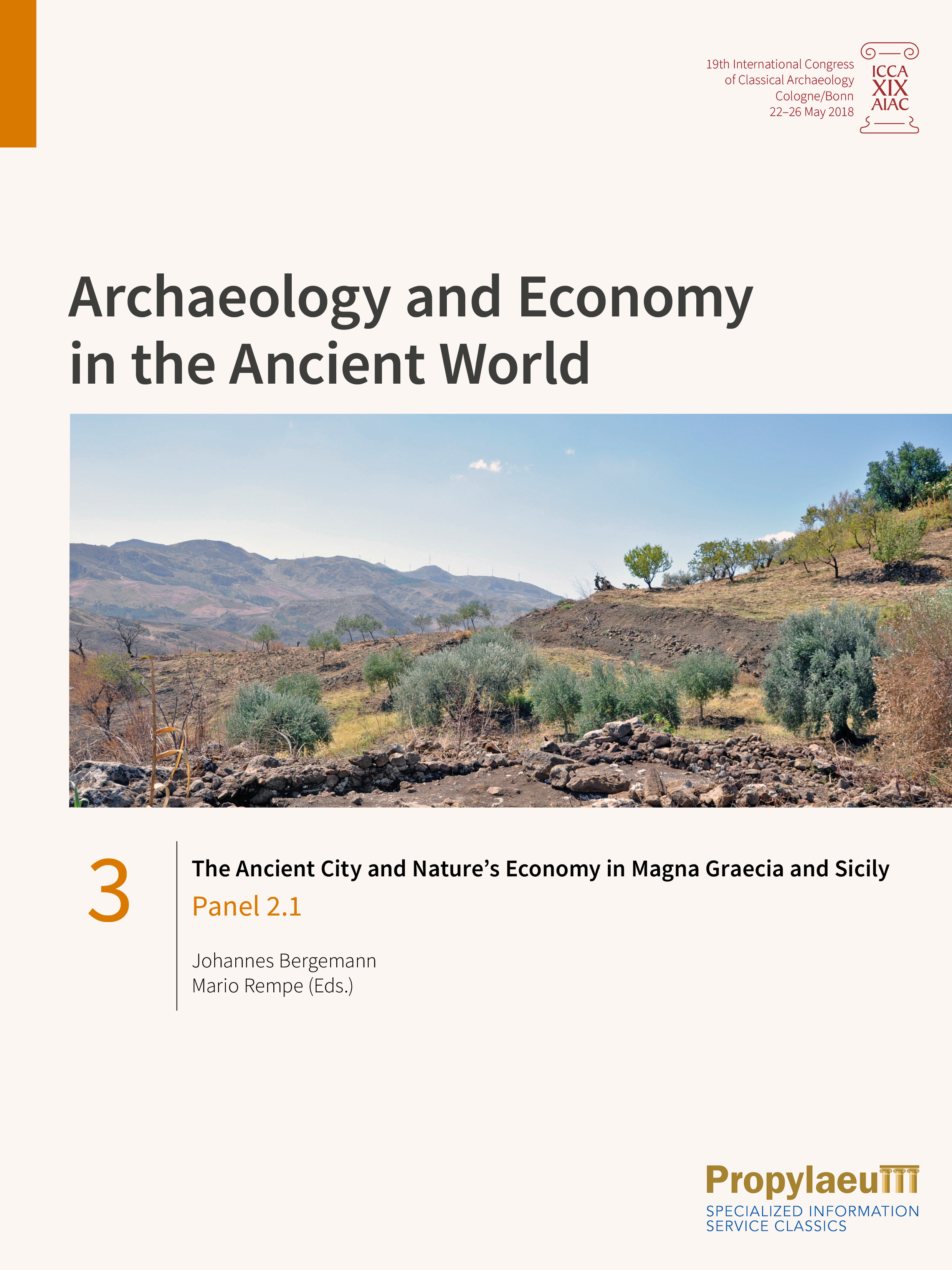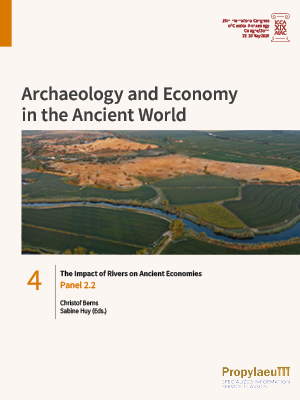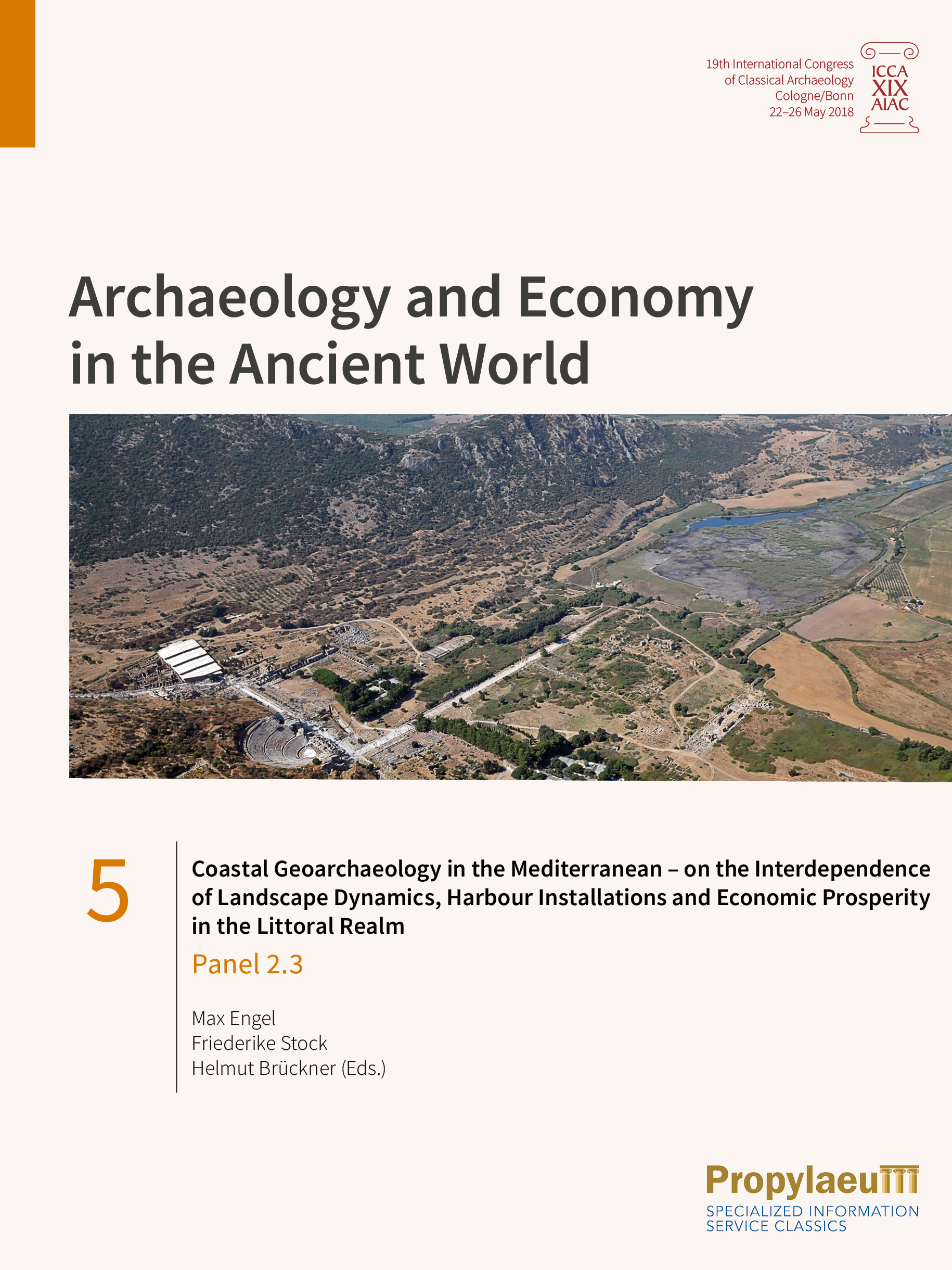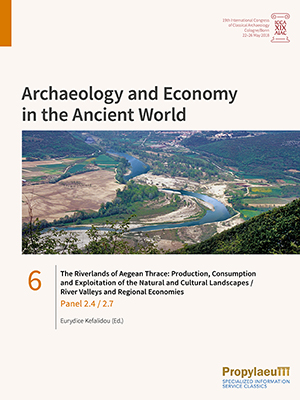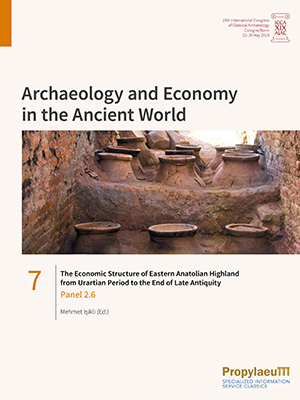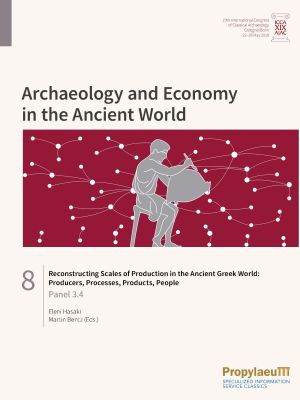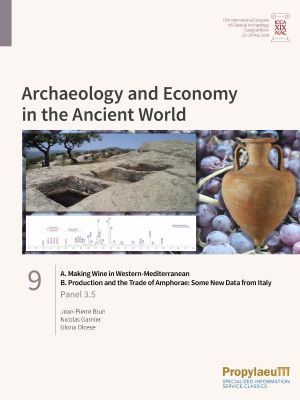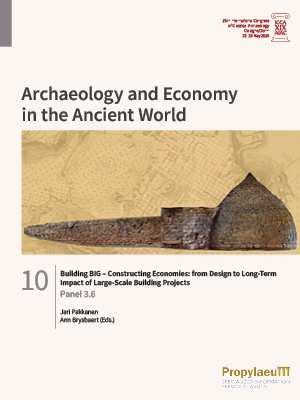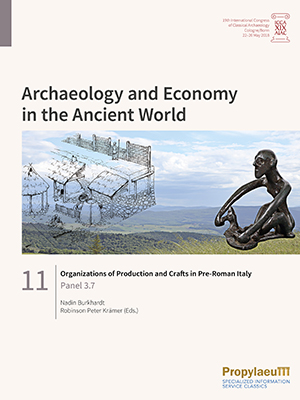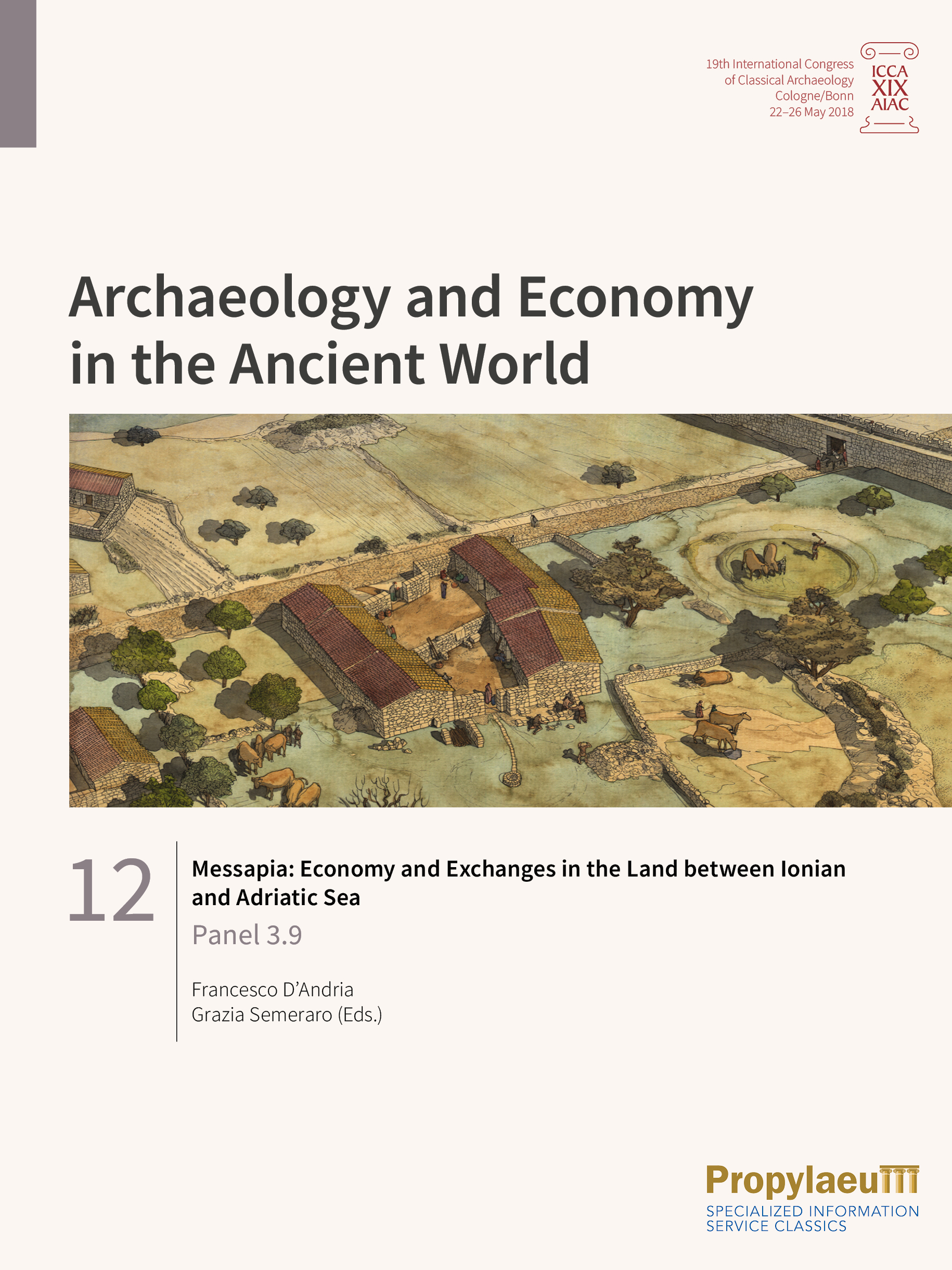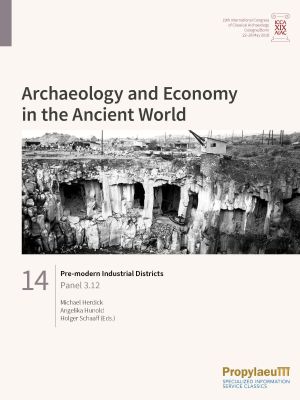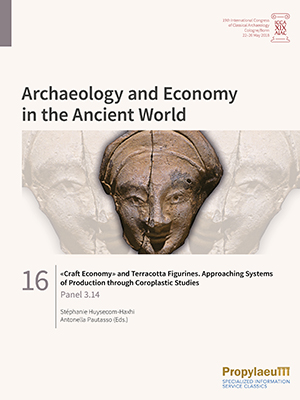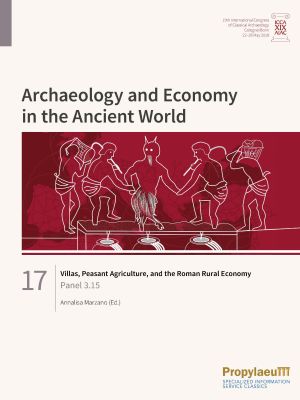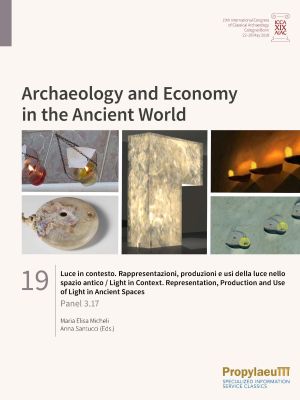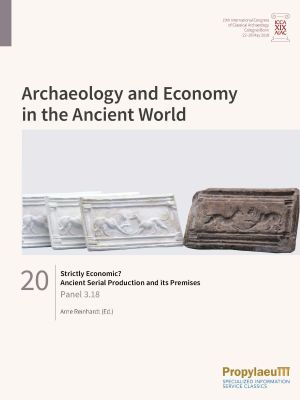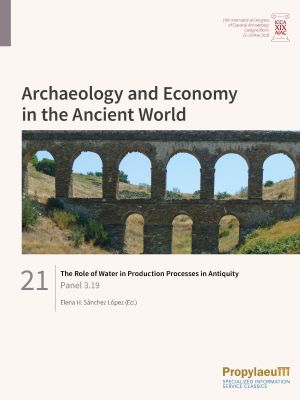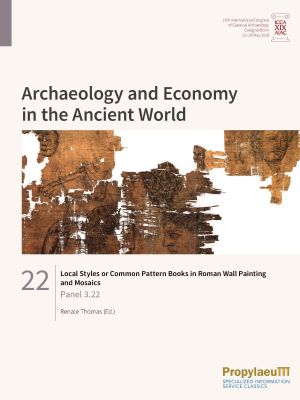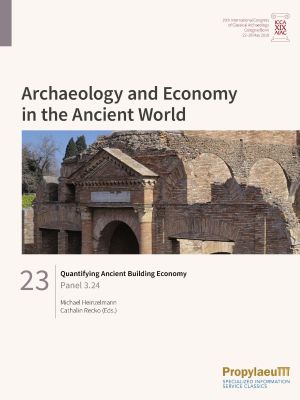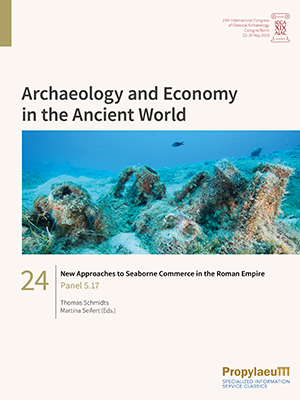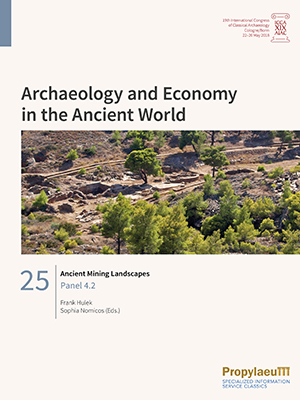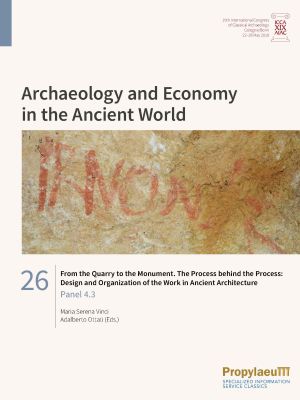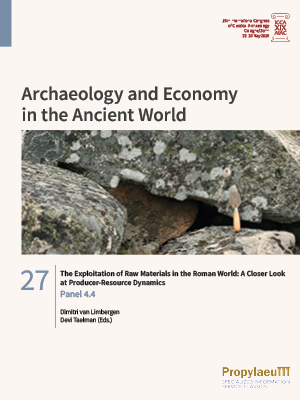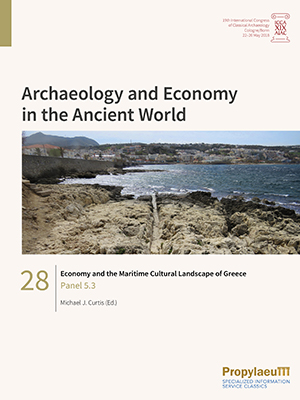Archaeology and Economy in the Ancient World
Proceedings of the 19th International Congress of Classical Archaeology, Cologne/Bonn 2018
These volumes form the final publication of the 19th International Congress of Classical Archaeology, which was held from 22 to 26 May 2018 in Cologne and Bonn on behalf of the 'Associazione Internazionale di Archaeologica Classica (AIAC)'. Under the title 'Archaeology and Economy in the Ancient World' more than 900 presentations, divided into 11 sections and 128 panels, dealt with various aspects of ancient economic history.
In fact, economic aspects permeate all areas of public and private life in ancient societies, whether in urban development, religion, art, housing, or in death. Research on ancient economies has long played a significant role in ancient history. Increasingly in the last decades, awareness has grown in archaeology that the material culture of ancient societies offers excellent opportunities for studying the structure, performance, and dynamics of ancient economic systems and economic processes. Therefore, the main objective of this congress was to understand economy as a central element of classical societies and to analyse its interaction with ecological, political, social, religious, and cultural backgrounds. The theme of the congress was addressed to all disciplines that deal with Greco-Roman civilization and their neighbouring cultures from the Aegean Bronze Age to the end of Late Antiquity.
In the present series, numerous panels are presented as independent thematic volumes (Volumes 1–52). The further contributions are compiled in four collective volumes (Volumes 53–56).
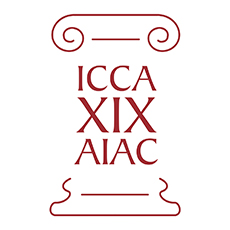
Editors
Prof. Dr. Martin Bentz
Institut für Archäologie und Kulturanthropologie
Universität Bonn
Prof. Dr. Michael Heinzelmann
Archäologisches Institut
Universität zu Köln
Internet: 19. ICCA 2018
Email: congress.aiac2018@uni-bonn.de
Published so far
Wealthy and Healthy? Methodological Approaches to Non-Élite Burials: Panel 1.2
The analysis of ancient societies beyond the political system, leading actors, and élite groups relies heavily on the archaeological record. Abundantly preserved burial sites present a major part of ancient testimonies. Yet, neither are burials with their grave goods a mirror of past lives nor do non-élite burials necessarily equal poor burials, and we need a mixture of criteria to identify non-élite as well as non-poor burials. The bones of the deceased are, however, first class bio-historical sources. There is a strong correlation between wealth and health in antiquity and human remains reflect the social status via diet and health.
With respect to various methodological approaches to funerary archaeology linking the capacities of material culture studies to social and natural sciences, the contributions in this volume explore the relationship between material culture, health and social status. They evaluate non-élite burials regarding the social persona and life style of the deceased as much as the ideology of the descendants expressing their beliefs through the burial process. Precisely the focus on context analysis – aiming beyond the funerary sphere – constitutes the importance of the case studies united in this volume.
The Economic Contribution of Migrants to Ancient Societies. Technological Transfer, Integration, Exploitation and Interaction of Economic Mentalities: Panel 1.3
Archaeological studies on migrants usually focus on their role in production activities, either as part of the labour force, or as specialized craftsmen dependent on local entrepreneurs, families or public institutions. This book aims to overcome this unidirectional discourse on dependency and to propose an alternative approach, examining migrants as actors in the economic life of ancient societies. The economic dimension of migration is thus analysed as part of the complex dynamics of integration and segregation in local communities. Migrants are considered as consumers, cultural mediators, social climbers, promoters of different lifestyles, and as ‘triggers’ for innovation. The papers in this volume suggest new methodologies and interpretative paths, dealing with a wide spectrum of case studies from the Middle Kingdom Egypt to the Bronze and Iron Age of the western Mediterranean, from Classical Greece to Hellenistic Etruria, concluding with the Przeworsk Culture of Pannonia. Overcoming the binary oppositions usually set up between colonists and indigenous peoples, locals and incomers, this book points out how economic mentalities are part of a greater entanglement of personal, social and economic identities.
The Ancient City and Nature's Economy in Magna Graecia and Sicily: Panel 2.1
The panel offered archaeological landscape studies and paleoenvironmental reconstructions, thus shedding light on human-environment interactions. Archaeological research combined with Earth Sciences made different patterns of these interactions visible at several sites in Magna Graecia and Sicily.
Approaches combined archaeological methods with Geoarchaeology, Palynology, Zooarchaeology, and Climate History. The case studies covered a long period, reaching back to the early phases of Greek settlement on Sicily. Moreover, shifts in settlement dynamics between Roman and Greek times were observed and hypotheses created by taking a paleoenvironmental perspective. At the same time, economic and social implications and their effects on the data were considered. Examples originated from survey archaeology as well as from samples gained during excavations.
The Impact of Rivers on Ancient Economies: Panel 2.2
The increased interest in the mutual interdependence of socio-cultural and physical spaces has led to the fact that watercourses have gained in importance as a formative factor of societies. Landscapes shaped by rivers provide characteristics and specific conditions that have a major impact on the economic life of people living in riverine contexts. Rivers are significant natural resources and offer special opportunities for economic activities. They can act both as connecting arteries and as borderlines. The contributions of our panel describe rivers as dynamic factors of ancient communities and their economy. The articles presented in this volume focus on the interrelation between river landscapes and the economic habits of their inhabitants. The case studies cover a wide range of epochs and geographical areas and discuss phenomena such as geomorphic and anthropogenic changes in rivers, the role of rivers as transport and trade routes and their impact on settlement patterns.
Coastal Geoarchaeology in the Mediterranean – on the Interdependence of Landscape Dynamics, Harbour Installations and Economic Prosperity in the Littoral Realm: Panel 2.3
Mediterranean coastlines are highly dynamic landscapes, shifting up to tens of kilometres during the last ca. six millennia in the case of prograding delta plains. In these low-lying coastal environments, many ancient harbour installations became landlocked with severe impacts on the political and economic situation as well as the status of urban centres and their hinterland. At the same time, rising relative sea levels may have resulted in the salinization of aquifers and adverse effects on agricultural production. This collection of papers from Panel 2.3 “Coastal geoarchaeology in the Mediterranean – on the interdependence of landscape dynamics, harbour installations and economic prosperity in the littoral realm” covers those topics for different parts of the Mediterranean geographical entity over the last 2500 years. These studies successfully demonstrate how geoscience data either help to locate harbour sites or how they support the interpretation of archaeological remains and literature sources of ancient authors. Each contribution therefore represents a striking example for the relevance of interdisciplinary approaches in archaeology, as summarized in the concept of geoarchaeology.
The Riverlands of Aegean Thrace: Production, Consumption and Exploitation of the Natural and Cultural Landscapes | River Valleys and Regional Economies: Panel 2.4 | Panel 2.7
Rivers have always been vital supports for economies. They provided water for people and animals, irrigated the land, facilitated communication and trade through small vessels or rafts, aided industrial activities, formed rich hunting grounds for fishermen and hunters, and offered raw materials such as sand, gravel and placer deposits - including even gold. At the same time, the deltas and marshlands of rivers, created an inhospitable environment unsuitable for habitation, especially in periods of flood. Furthermore, rivers connected the sea and the littoral zone with the hinterland, and thus allowed the interaction between the populations which inhabited these areas, often locals and colonists/merchants.
The papers address topics such as the reconfiguration of ancient river routes, the settlement and exploitation patterns that were formed around them, the boundaries of the chora of various cities, towns, villages and farmsteads, and the communication or the tensions between different groups that moved or expanded beyond their original habitation zone due to environmental and/or economic reasons.
Panels 2.4 and 2.7 explore multiple facets of some Central and Eastern Mediterranean riverlands. Panel 2.4 investigates Aegean Thrace, i.e. the Northeastern part of Greece and the European part of Turkey. Panel 2.7 looks at three river valleys in two different areas: Athens and Attica with the Ilissos River; and Northeastern Italy with the rivers that flow in the areas of Verona and Parma.
The Economic Structure of Eastern Anatolian Highland from Urartian Period to the End of Late Antiquity: Panel 2.6
The Eastern Anatolian Highlands was one of the prominent sub-regions of the ancient Near East due to its very specific location. This region, which has rugged geographical features and harsh climate conditions, is situated between Northern Mesopotamia, the Southern Caucasus, Northwestern Iran and Central Anatolia, each of which were important cultural regions of the Near East. The Eastern Anatolian Highlands have played an important role in the economic networks and cultural relationships developed between the southern and northern regions through the ages. Despite its difficult geography and unfavourable climate conditions, the region hosted many cultures and societies through time on account of its strategic location and richness in natural resources and raw materials. The archaeological evidence shows that the initial periods of centralization and state formation in the region began with Urartu and continued through time. The most important factor in this regard is the fact that the region effectively functioned as a transit point on account of its strategic geographic position. Thereafter, the economic and political structures in this mountainous zone of the Near East are more easily observed. The economic structures of this marginal zone of the ancient Near East will be analysed from the Urartian period to the end of Late Antiquity in this session.
Reconstructing Scales of Production in the Ancient Greek World: Producers, Processes, Products, People: Panel 3.4
Scholars have adopted an array of approaches, both traditional and experimental, to approximate the scale of craft production, which has always been central to the study of ancient economies. This panel examines these new methods, for estimating the workshop crew size, the workshop physical space, the time requirements for the chaîne opératoire for each product, the needs of the population for different goods, or the percentage of ancient products surviving to this day. These new approaches, some borrowed from related disciplines, should help us overcome the paucity of archaeological evidence. By employing social network analysis, individual worker’s output, architectural energetics, and production-consumption ratios, we aim to improve our understanding of the scale of craft production in the ancient Greek world, both in the Greek mainland and in the Greek colonies in Sicily. Archaeologists and ancient economists are using new approaches to study the ancient economy at a micro-level, taking into consideration several variables, such as raw material procurement, labor investment, cross-craft dependencies, apprenticeship periods, and product demand, to name a few. From Prehistoric to Classical Greece and Italy, the industries covered are mostly ceramics-centered, such as pottery and tiles, but also pavement construction and funerary monumental architecture.
A. Making Wine in Western-Mediterranean B. Production and the Trade of Amphorae: Some New Data from Italy: Panel 3.5
The aim of this volume is to present new data and current multidisciplinary projects on viticulture in antiquity, on the production and circulation of wine, and on the containers that held the wine, involving archaeology, archaeometry, archaeobotany and molecular-archaeology.
The studies in this volume focus on Italy, and its relations to other areas (Spain, Malta), to deepen our knowledge of the transformations in the agricultural landscape. Another focus are wine production facilities, which have until now remained under-studied, such as rock cut vats.
The advancement of technical knowledge is gradually answering the old question of differentiating between wine and olive oil production facilities. We knew that the same presses were used for both products, but now, systematic floatation can turn up olive stones or grape seeds, and biochemical analyses in gas-chromatography or liquid-chromatography coupled with mass-spectrometry now provide very reliable results on the remains in vats.
The second part of the volume presents some new archaeological and archaeometric data related to the production and distribution of wine amphorae - coming from the Tyrrhenian coast of Italy, Spain and Africa - in Italy and the western Mediterranean, the study of which was also carried out using laboratory methods.
Building BIG – Constructing Economies: from Design to Long-Term Impact of Large-Scale Building Projects: Panel 3.6
This volume contains various studies that range from prehistoric Greek building programmes to building in the Roman period. The economic growth of modern societies has been closely linked with construction industries: investments, transport infrastructures for materials and labour-intensive building programmes all have a large impact on local, regional and even global economies. The end results have shaped the built environment of our everyday lives and have often led to an increased quality of life and affluence, though there are many cases that did the opposite as well. Large-scale building projects in pre-industrial societies required extensive manual labour to be invested from the moment materials were scouted for, over the extraction, transportation, use and the subsequent maintenance. Since most ancient societies were based on subsistence economies, important decision-making was a daily balancing act between building work and agriculture. These decisions often strongly influenced the patterns of land use and may have also resulted in circular economic strategies. The papers presented in this volume emphasise the importance of the socio-economic and political structures and decision-making that resulted in ‘Building Big’, irrespective of the shape and final size of the projects.
Organizations of Production and Crafts in Pre-Roman Italy: Panel 3.7
While economic approaches are becoming generally more important and even mainstream topics, this is not necessarily the case for research into Pre-Roman Italy, defined as the area of the Italian Peninsula, Sicily and Sardinia during the Iron Age. Until recently, there was almost no research into Pre-Roman Italy focused on economic studies, and the existing research has been mostly dedicated to very specific contexts:
(1) specialization of crafts and production in the context of urbanization processes; (2) specific production areas, such as agriculture, metal processing, and salt production; (3) studies focusing on Greek Colonies and Greek Colonial encounters with indigenous populations; (4) analyses of consumption patterns, mainly in the case of Greek pottery consumption. Recent excavations and investigations devoted to the study of workshop structures, such as those at Gabii, Pithekoussai, Kroton, Lokroi Epizephyrioi, Naxos, Selinunt and Kyme / Cumae, have provided a range of new data that is stimulating a valuable and highly constructive discussion on the organization of production and crafts in Pre-Roman Italy. Against this background, four members of the study group ‘Etruscans and Italic Cultures’ from the ‘German Association of Archaeologists’ (Arbeitsgemeinschaft Etrusker und Italiker des DArV e.V.) formed a panel to discuss the economic aspects of Pre-Roman Italy on the basis of their ongoing research projects: all of these focus on the field of production and crafts. The aim is to contribute to an intensified debate on geographical, chronological and functional patterns in the organization of crafts and productions by discussing current case studies and methods.
Messapia: Economy and Exchanges in the Land between Ionian and Adriatic Sea: Panel 3.9
Ever since the Bronze Age, the geographical position of Messapia, between the Ionian and Adriatic seas, has enabled the development of relations characterised by continuity within the framework of mobility in the Mediterranean. This volume focuses on certain aspects of the economy in Messapia, with particular reference to bio-archaeological themes (including livestock rearing and the consumption of animal resources), textile production (applying archaeometric methods to residues of fabric) and imports of luxury products from Greek cities and the Greek colonies of southern Italy. The presence in grave goods of imported prestige items has been investigated with reference to the forms of self-representation adopted by the Messapian aristocracy in both funerary rituals and manifestations of power within the settlements. The variety of religious manifestations in the Messapian world constitutes a particular case study linked to cultural exchanges, which, thanks to the recent discoveries of places of worship, can now be investigated in detail. Important in this regard are the discoveries made in Castro, where the Athenaion – linked to the myth of Aeneas’s first landing on the shores of Italy – was identified.
Pre-modern Industrial Districts: Panel 3.12
The ancient quarrying and mining district of the Eastern Eifel has been the subject of research by the Römisch-Germanisches Zentralmuseum (RGZM) in Mainz and Mayen since 1997. The products – primarily basalt lava millstones, tuffstone building material, and pottery – were extensively traded throughout much of Europe for many centuries.
An extensive research programme was launched to examine the wealth of evidence about the ancient stone industry in the region and its significance for the political establishment of Rome north of the Alps. The main subjects were the basalt and tuff stone industries as well as the Mayen vicus, the most important economic centre. Another subject is the pottery production, which is researched by material studies as well as by experimental archaeology. Other studies deal with the preconditions for the economic success, focussing on the infrastructure and the rural settlement conditions.
Being an industrial district of supraregional importance, the quarrying and mining district of the Eastern Eifel turned out an excellent case study for the investigation of pre-modern industrial districts in general, providing a model for the study of ancient industries: these need to be investigated with a long-term view and with a holistic approach, taking into account economic, social and settlement aspects.
«Craft Economy» and Terracotta Figurines. Approaching Systems of Production through Coroplastic Studies: Panel 3.14
Coroplastic studies have been developing in recent years due in particular to a different perception of terracotta figurines which are no longer considered as decorative objects but as privileged evidences of artisanal, socio-cultural and religious practices of the societies in which they were produced and used.
This volume is dedicated particularly to the craft practices and the processes and motivations that led to the production and the wide diffusion of terracotta figurines through the ancient world. The studies presented here, still in progress, are essentially based on a in-depth observation of the objects which are often the only remains excavated, as few workshops with all the tools and structures necessary for the manufacture of these artefacts have been recognized and studied so far. The object, whether moulds or figurines, is thus at the heart of coroplastic studies.
Different coroplastic sets, from various contexts in different geographical areas, are presented here, with the aim of comparing information on several problems concerning the manufacturing techniques, production processes and workshop faciès. Two main fields were explored: firstly the technical expertise and characteristic handiwork of the craftsmen, and furthermore the reconstruction of activities within the workshops, whose functioning and faciès may vary from case to case. The contributions collected in this volume thus provide some interesting insights that may help future researches in this growing scientific discipline.
Villas, Peasant Agriculture, and the Roman Rural Economy: Panel 3.15
The Roman villa was a defining element of the Roman world and its appearance and spread, both in various regions of Roman Italy and abroad, have been linked to various historical phenomena: Rome’s territorial expansion, the establishment of colonial settlements, and the indigenous elites’ readiness to participate in forms of Roman life. While traditional historiography has seen the spread of large villas in Republican Italy as a phenomenon that displaced small and medium landowners from the land, and thus contributed to Rome’s socio-political problems, recent studies have stressed that large villas and farms were not at variance with each other. The papers gathered in this volume aim at giving a more organic evaluation of how the ‘villa economy’ and the ‘peasant economy’ operated, and to what degree, if any, the two were integrated. It does so by addressing two main questions: whether villas and small and medium farms were part of two distinctive productive and distributive systems or not; and to what extent the picture emerging from provincial territories compares with the situation in Roman Italy.
Luce in contesto. Rappresentazioni, produzioni e usi della luce nello spazio antico / Light in Context. Representation, Production and Use of Light in Ancient Spaces: Panel 3.17
Ancient authors and archaeological sources provide evicence for the central role of the light in the ancient life and thought. The analysis of this argument through an ideal dialogue with the contemporary lighting culture contributes to point out new and different research areas. If the lighting devices (clay, glass, metal and marble made lamps, candlesticks, chandeliers etc.) testify dynamics of production, distribution and use system, according to different historical and social contexts, on other hand, the study of an olive regional production district and its relation with the fuel supply reflects on socio-economic issues and related changes. Actually facing with the ancient light perception are the esperiments on different oils as an attempt to measure artificial light intensity and duration together with a 3D modelling study on a tomb and its niches for lamps. Light affects, 'create' and 're-create' everything as suggestively evidenced by ancient paintings as well as by contemporary architecture and lighting technologies.
Strictly Economic? Ancient Serial Production and its Premises: Panel 3.18
The complex subject of production and consumption in antiquity has been attracting growing interest in Classical Archaeology for some time. Research with an economic perspective, such as the investigation of the dynamics of the production of objects or ornaments in Antiquity, has opened up new insights into Greco-Roman culture. Against this background, the present volume focuses on a particular method of production: serial production. On the basis of close-up observations of the finds, the authors of the volume illuminate the broad spectrum of ancient serial production in Greece and Rome in exemplary fashion; the examples deal with a range from (late) Classical ceramics with painted decoration to mechanically reproduced coins and relief tableware to luxurious marble urns. The aim is first describing individual series and defining them and subsequently using this information to interpret the respective conditions that led to the series. This process demonstrates that the phenomenon of serial production (and seriality more generally) consistently transcends economic aspects and seamlessly leads over into other areas of ancient cultural history and its research.
The Role of Water in Production Processes in Antiquity: Panel 3.19
Water is required in many production processes, both now and in the past. But water studies have traditionally focused on the analysis of water supply structures, in particular on aqueducts and monumental fountains, leaving aside most of the uses given to this precious liquid after bringing it into the urban settlements. Apart from the baths – already included in water studies decades ago – Classical Archaeologist have only recently begun to take into consideration other uses of water. Nevertheless, the uses related directly to productive activities have never been properly addressed.
Agriculture, pottery or glass production, building materials and construction techniques, are very common issues in recent research, however, the study of the different processes related to each of those activities has aroused much less interest and the role of water within these processes has been totally neglected. This volume includes four papers that are a first attempt to study water in production processes in the Roman period and in Late Antiquity.
Local Styles or Common Pattern Books in Roman Wall Painting and Mosaics: Panel 3.22
The presentations of the panel "Local styles or common pattern books in Roman mural painting and mosaics" illustrated various aspects of the working methods of ancient workshops and their production. I. Bragantini used the example of the wall paintings in Cartagena and Lyon to emphasise these were made by Italian workshops that in her opinion. While St. Falzone, M. Marano and P. Tomassini focused on the characteristics of the local style in wall painting in Ostia, C. Sbrolli concentrated on the iconographic characteristics of the 'Workshop of the Vetti' in Pompeii. E. Moormann and D. Esposito investigated the question of whether the development of wall painting in Flavian times testified to continuity or a new impulse. C. Boschetti et al. highlighted the differences in the production of mosaics in Aquileia between the Augustan period and the 4th century AD: while the first workshops worked with high quality materials from Campania and probably came from there, the later mosaicists were probably local, as they used cheap materials available locally. B. Tober pointed out that there was an 'international' agreement on the manner of appointing certain room for certain functions. E. Aydogdu and A. Kazim Öz used a mosaic in Metropolis as an example to show that three-dimensional leaf patterns are also based on models that go back to geometric forms.
Quantifying Ancient Building Economy: Panel 3.24
In recent years, the study of ancient construction has focused increasingly on putting the different aspects of the process of building into an economic framework. This entailed examining the various steps of construction and the organization of a building site in detail. It also meant that attempts were made to quantify the use of both the materials and the labour necessary for the building project, as these illustrate the scale of a building project and its impact on the overall economy.
The goal of this volume is to bring together different approaches of the study of the economy of building. With the help of methods of quantification and intensive architectural studies, the case studies of city walls, baths, temples and timber buildings in this volume not only shed light on the various constructional characteristics of these buildings, but also on a wide range of economic implications. The collection of papers ranges from Messene in the 4th century BC to Imperial Rome and are completed by practical insights from 19th century building manuals.
New Approaches to Seaborne Commerce in the Roman Empire: Panel 5.17
Seaborne commerce in the Roman Empire is characterised by a remarkable efficiency for the pre-modern world. From Egypt to Britain, trade connections can be proven on the basis of archaeological finds. The range of these activities includes the Mediterranean, the Black Sea and parts of the north-eastern Atlantic. Important reference points for the assessment of Roman merchant shipping are ports, ships and cargo remains. Due to the large number of known shipwrecks and ports, archaeology in particular can contribute to a better understanding of maritime trade.
The contributions address various aspects of the "seaborne commerce" with a broad methodological spectrum. In addition to wreck finds, the relevance of inscriptions on amphorae and other cargo remains are considered as well as the formation of networks, the reconstruction of ship routes and the performance of ancient watercraft based on experiments.
Ancient Mining Landscapes: Panel 4.2
The economic importance of raw material exploitation, especially metal mining, for communities in antiquity has long since been addressed. Only during recent decades, however, have scholars increasingly focused the material remains. These include not only the primary mining remains, such as underground workings, process residues and installations for beneficiation, but also habitational sites and infrastructural remains that emerged in the course of exploitation.
The intention of this panel at the 19th International Congress for Classical Archaeology was to provide an insight on existing and emerging research on landscapes that were distinctly transformed by mining. It aimed furthermore at discussing how mining could affect not only the natural but also the cultural landscape. By focusing on select case studies, the intention was to identify the material characteristics of such areas, to highlight and explain differences and to discuss possible recurring infrastructural and organisational patterns.
From the Quarry to the Monument. The Process behind the Process: Design and Organization of the Work in Ancient Architecture: Panel 4.3
In the complex economic and constructive system of the erection of a building, the planning and organizational aspects of the work represent the first fundamental steps towards reaching a satisfactory final product. Skilled workers are a crucial element of this process, as they have the technical knowledge of the quarrying and building processes that guarantee a successful outcome at the building site (cantiere di costruzione).
This volume aims to explore ancient construction, working procedures and the transmission of technical expertise by skilled workers. Covering different chronological ranges and geographical areas, it focuses on two main subjects: quarry marks or notae lapicidinarum and carving lines for planning architecture and artefacts. They are two aspects of the three-dimensional materialization of the plan and the organizational processes within the building activities. Quarry and mason’s marks are a kind of building material ‘tracking code’ from the extraction point to its final placement. The carving lines represent guidelines useful for the building’s planning and the positioning of stone and marble elements. This volume is a first attempt at contributing with original and innovative thought on the networking of workshops, linking quarrying and building activities in ancient world.
The Exploitation of Raw Materials in the Roman World: A Closer Look at Producer-Resource Dynamics: Panel 4.4
Compared to other pre-modern economies, the Roman world stands out for having developed a highly specialised and very productive manufacturing sector. This development led to the widespread and large-scale extraction of raw materials. Even in a territory as large as the Roman Empire, such activities put major
pressure on the land. Strategies of resource exploitation and conservation were thus essential in dealing successfully with the limited availability of these resources in the medium or long term, and to ensure the sustainability of the Roman exploitation model. This volume deals with the various ways in which natural resources were exploited and managed in the Roman world. It focuses on if, when, where and how the Romans pursued a harmonious balance between the limited availability of a particular resource and the law of supply and demand. The case studies in this volume cover various key areas of the Western Roman world – from Italy and the island of Elba, over coastal Croatia to Central-Eastern Gaul and the Pannonian limes – and discuss in particular the fi sh industry, iron smelting, deforestation and forest management, the stone trade and the exploitation of thermo-mineral resources.
Economy and the Maritime Cultural Landscape of Greece: Panel 5.3
In recent years new research and investigation along the coastlines has added to our understanding of the maritime cultures and traditions of ancient Greece. Even so, the maritime cultures, traditions and social aspects remain understudied and the traditional boundaries between terrestrial and underwater archaeology are still problematic and a challenge to researchers. Throughout time the settlements that stood beside the sea became increasingly important to local and regional economies, as they often benefitted from local, inter-island and cross-Mediterranean trade and the commercial and networking opportunities that this offered. Many of these settlements were the first point of contact for seafarers, travellers, and migrants, playing an important role in the diffusion of cultural, political, and religious ideologies.
The papers in this volume take us on a journey in time from an Early Bronze Age settlement on Paros to the Closed Harbours of Archaic and Classical Greece, and on to life in Hellenistic and Roman Crete. Whilst being preliminary perspectives, the contributions in this volume demonstrate the broad variance in subject material and offer an interesting insight into the world of maritime Greece.



